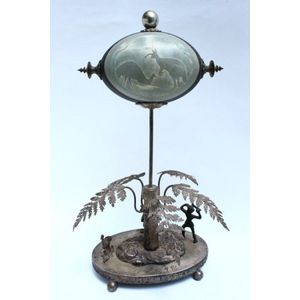Chinese Silver Serving Basket with Shrimp and Florals
You must be a subscriber, and be logged in to view price and dealer details.
Subscribe Now to view actual auction price for this item
When you subscribe, you have the option of setting the currency in which to display prices to $Au, $US, $NZ or Stg.
- Embossed / Repousse - Embossing, also known as repousse, is the technique of decorating metal with raised designs, by pressing or beating out the design from the reverse side of the object.It is the opposite of chasing, where the decoration is applied from the front. An embossed or repoussed object may have chasing applied to finish off the design.
- Hammered - A hammered finish on metal wares is achieved by striking the surface of the metal with a hammer to create a series of small, uniform indentations. The indentations can be made in a variety of patterns and depths. The resulting surface texture can vary from a subtle, almost imperceptible texture to a highly textured surface with a strong, pronounced pattern.
The hammered finish adds texture and visual interest to metal objects such as bowls, vases, and other decorative items. It can also be used to add grip or reduce glare on tools, weapons, and other functional metal objects.
A hammered finish can be applied to a range of metals, including copper, brass, silver, and gold.
This item has been included into following indexes:
Visually similar items

George III sterling silver wing handled cake basket, with slat pierced work banding half fluted interior and beaded edges by Charles Aldridge and Henry green London 1780, 910g and 36 cm long

English hallmarked sterling silver George III ladle in the fiddle pattern. London, 1814, maker James Wintle, condition good, minor age related wear. Length 33 cm weight 178g

Australian silver plate and emu egg centrepiece, with central emu egg carved with kangaroo and emu, above fern leaves, above Aborigine holding boomerang, kangaroo and emu, all on oval base, on four ball feet, engraved initials to base, a/f to egg

Line Marker, showing on lid 'Olympic Games/ (Olympic rings)/ Linemaster'. Unusual and scarce
